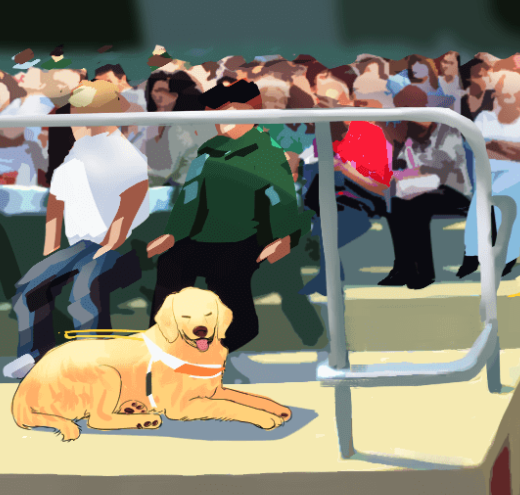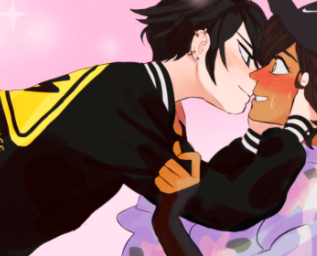When playing Butterfly Soup, I was initially startled by Min Seo’s aggressive personality and embrace of violence. Her decision to hit strangers with a bat to get popcorn – though maybe charming to some – was a bit off-putting. Yet interestingly, I found myself far more emotionally invested in the interaction immediately before: getting to pet a nearby dog.

This strange level of emotional detachment from non-playable human characters (NPCs) compared to my investment in their animal counterparts piqued my interest. Why is it that players gravitate so heavily to pets in games and how does this reflect character interaction in gameplay more generally?
To help answer these questions, we can turn to the First Person Shooter (FPS) genre, as it provides insight into why violence is normalized against humans and less so to animals. Consider that the objective of most FPS games is to advance through levels in a first-person perspective while killing enemy unit soldiers using weapons you collect along the way. Oftentimes, these games will feature human or otherwise humanoid enemies that can attack in relatively similar ways to yourself. Through this lens, humanoids can be viewed as obstacles, whether to one’s health or timing, that must be overcome to advance through a level. Animals typically pose less pressing obstacles and sometimes even lead players to special rewards and items such as in Breath of the Wild.
Nonetheless, recent games such as The Last of US 2 complicate this dichotomy by introducing dogs as both potential allies and as enemy characters. As a result, players are forced to confront their preconceived notions about pets in games to elicit a disturbing emotional response. Personally, I would struggle to attack an NPC dog even if in self-defense, which is a testament to how strongly I become invested in the well-being of these fictional characters.
I believe that players become so heavily invested in the well-being of pets for two important reasons. The first is how we converse with in-game pets compared to humans. With animals, we are encouraged to pay attention to body language in a manner that can be ignored during text-based, human dialogue.
In Butterfly Soup, our interaction with the dog is extremely limited. We ask to pet the dog, complete the task, and then leave. In fact, our dialogue with the dog owner is more extensive in comparison. Yet notably, our time with the dog requires more awareness of body language. Butterfly Soup takes an extreme stance in this case, as we never see the face of the dog owner and only the dog is clearly in focus. Other games, however, that do feature human NPCs invite players to spend relatively more time appealing to our five senses when meeting animals. We will hear dogs barking, see their tails wagging, and are even given opportunities to pet them. Humans can exhibit many of the same qualities that garner our attention. But the majority of our focus is spent on reading dialogue. Interacting with game dogs is more lifelike than human counterparts, to some extent.
Another factor explaining why players grow attached to in-game characters can be answered by considering what these characters mean to players. I believe that a sense of loyalty and affection is crucial to developing an emotional attachment to in-game characters. Dating simulators are a testament to this drive.
In a dating sim, the playable character must spend their time seeking to romance the many characters they encounter throughout the game. One of my personal favorites, Hatoful Boyfriend, sees you meeting and gaining the affection of pigeons that attend the same school as you. A notable trend throughout this genre is that the main character is intriguing to the characters around you, regularly gaining their affection and attention. This focus on gaining a loyal following reminds me, to an extent, of how we view pets. We value loyalty and the unconditional affection that they are expected to give.
Of course, not all in-game characters need to be romanced. Butterfly Soup engages viewers through detailed dialogue and strong character development (that eventually does lead to some romance). Nonetheless, the timelessness of friendship and loyalty remains a crucial theme in the relationship between Diya and Min-Seo.
In the end, we all want friends that will stay true to us no matter what. In-game characters tend to be exceptionally loyal and devoted to the well-being of your avatar, trying to lift your spirits throughout the game. Whether that is dogs, virtual friends, or yes, even waifus, they get the job done.


Hey, great blog post, really interesting to read on how we not only perceive dogs and other pets in video games but more specifically how we tend to normalize them even more than humans in video games, especially in stuff like First Person Shooters. I guess something to consider is do you think how we perceive dogs in the real world has any effect on how we treat dogs in video games? I mean, we’re supposed to treat people the way we want to be treated, yet when it comes to games, we have no problem beating up and gunning them down in the truckload, yet our love for dogs in the real world is translated exactly to how we treat pets in video games. Why do you think that is?
I think this is a really interesting point about what the developer can do to use outside elements (like how most people are really taken aback by the concept of hurting a dog as comparing to the mindless killing of humans that often appear in games) and use that in their game to make the player second guess their actions. Even more interesting is the point about the relationships with character, since I’ve seen myself liking murderous characters quite a bit — Nathan Drake being an example of someone who has murdered hundreds, but you still want to support him because of how he is written and how nice he sometimes is. At one point in Uncharted 4, for example, he pets a monkey and the monkey rides around his shoulder for a little bit — which immediately made him a lot more likable to me, even though he went on murder a few more NPCs a few minutes later. It’s really cool to think about what developers can do or are doing in order to make almost manipulate what the player feels.
How does the relationship towards these examples of loyal and loved characters change in relation to time spent with them? It’s interesting to note that brief animal interactions like the one you describe with the dog is a reoccurring phenomenon, but when you’re given saturated animal experiences like in Nintendogs, the player’s desire to be intimate with the animal, while still prevalent, may be forsaken for more competitive elements like winning dog competitions or getting rare materials. I think the relationship between characters treated as collectibles, whether collectibles of affection, combat capabilities, or other traits is interesting given how the sense of ownership makes them desirable enough to spend lots of time and resources in order to obtain. Do you think narrative characters can be built to have similar levels of devotion from players if they are handled in a particular way?
Something that came to mind immediately when reading your post was dogs dying in movies and the certain cultural phenomenon around it. There is quite a bit of attention and conversation given to the fact that not all–but many people–have more emotionally sensitive reactions to dog deaths than human deaths in movies. And I think this carries over into your discussion about having emotional connections to dogs in video games, possibly even more so because video games require an active interaction between the player and dog. I agree with your point about having to read a dog’s body language in the absence of dialogue, and to take it a step further I also think our connection with dogs in media also has to do with projection. In the absence of dialogue (which takes away a major mechanism of character development), the dog can mean to the viewer or player whatever they want the dog to mean; in the case of human characters, so much of who they are is decided for us. It makes me wonder if there could be a similar affect in games with silent characters who you don’t ever learn much about. I’ve never played a game like this, so I’d be curious in what ways it would be similar and different from projecting on a dog.
Reading this post about emotional connections with in-game characters reminds me a lot of my experiences with various Fire Emblem games. In Fire Emblem, the player is given an army of units that grows as the story progresses. During each chapter (level), the player can only deploy a limited amount of their total units, in which the units can gain experience and level up by defeating enemy units. In your post you mention connections with characters from a purely narrative standpoint. Adding onto that, I find that when I play Fire Emblem, I become attached to characters because they are useful, or because I like their dialogue, or more often than not a combination of both. Because of this, I find myself feeding stat-boosting items or giving my stronger weapons to units I like more than units that may take advantage of those items better. And I feel like this is the main appeal of Fire Emblem for me. The player gets to choose which units they use throughout the game, and will form emotional connections with them, not just through the narrative but also in combination with the gameplay.
I think your analysis of how loyalty and trust can account for the relationships we build with NPCs in videogames is spot on. I think forming emotional attachments, either various NPCs or animals in video games can really make for a more personal and meaningful experience for the player. Your post overall made me think about games like Fallout, which allow you to choose companions to follow you around during your adventures. I’d often pick characters which were either reliable in battle (had good stats, would cover me well) or had likeable personalities, often relegating other, more grating characters to the sidelines. Coincidentally, one of my favorite companions in Fallout 4 is Dogmeat, a dog like his name suggests. What’s not to love about a friendly canine who follows you around and assists you in battle?
I like your take on attachment to NPC’s! Something I found that drew me to the dog in Butterfly Soup was Diya’s expressed interest in dogs, and the fact that we technically aren’t playing directly as ourselves but as her. I found myself trying to play the role of Diya, so I went to the dog immediately. If Butterfly Soup were more of a self-insert dating sim type of visual novel, then I probably would have done something else (I’m kind of scared of dogs). Though, I will say that in Breath of the Wild I would also rush to the dogs at the stables. Still, I feel like the question of role-playing and thinking of how we’re ~supposed~ to act in front of other people plays into gameplay. Will you be super rude to that waifu in the game because you don’t like her, when in real life you would probably just act normal? How does the experience of a game change our way of interacting with the virtual world and its inhabitants?